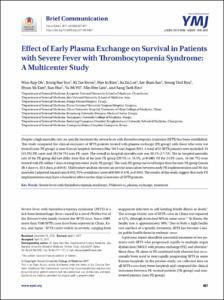KUMEL Repository
1. Journal Papers (연구논문)
1. School of Medicine (의과대학)
Dept. of Internal Medicine (내과학)
Effect of Early Plasma Exchange on Survival in Patients with Severe Fever with Thrombocytopenia Syndrome: A Multicenter Study
- Keimyung Author(s)
- Ryu, Seong Yeol; Kim, Hyun Ah
- Department
- Dept. of Internal Medicine (내과학)
- Journal Title
- Yonsei Medical Journal
- Issued Date
- 2017
- Volume
- 58
- Issue
- 4
- Abstract
- Despite a high mortality rate, no specific treatment for severe fever with thrombocytopenia syndrome (SFTS) has been established. This study compared the clinical outcomes of SFTS patients treated with plasma exchange (PE group) with those who were not treated (non-PE group) at nine Korean hospitals between May 2013 and August 2015. A total of 53 SFTS patients were included: 24 (45.3%) PE cases and 29 (54.7%) non-PE cases. The overall in-hospital mortality rate was 32.1% (17/53). The in-hospital mortality rate of the PE group did not differ from that of the non-PE group (29.3% vs. 34.5%, p=0.680). Of the 24 PE cases, 16 (66.7%) were treated with PE within 7 days of symptom onset (early PE group). The early PE group survived longer than the non-PE group (mean 28.4 days vs. 22.6 days, p=0.044). Multivariate analysis showed an inverse association between early PE implementation and 30-day mortality (adjusted hazard ratio 0.052, 95% confidence interval 0.004-0.678, p=0.024). The results of this study suggest that early PE implementation may have a beneficial effect on the clinical outcome of SFTS patients.
- Publisher
- School of Medicine (의과대학)
- Citation
- Won Sup Oh et al. (2017). Effect of Early Plasma Exchange on Survival in Patients with Severe Fever with Thrombocytopenia Syndrome: A Multicenter Study. Yonsei Medical Journal, 58(4), 867–871. doi: 10.3349/ymj.2017.58.4.867
- Type
- Article
- ISSN
- 0513-5796
- Appears in Collections:
- 1. School of Medicine (의과대학) > Dept. of Internal Medicine (내과학)
- 파일 목록
-
-
Download
 oak-2018-0419.pdf
기타 데이터 / 584.81 kB / Adobe PDF
oak-2018-0419.pdf
기타 데이터 / 584.81 kB / Adobe PDF
-
Items in Repository are protected by copyright, with all rights reserved, unless otherwise indicated.